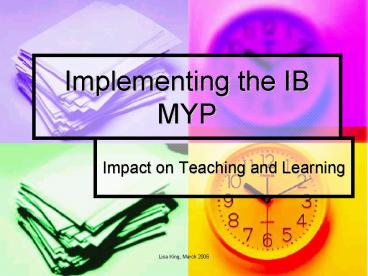Implementing the IB MYP PowerPoint PPT Presentation
1 / 19
Title: Implementing the IB MYP
1
Implementing the IB MYP
- Impact on Teaching and Learning
2
Today we will discuss
- What can the MYP do for a school?
- What can the MYP do for your student?
3
What can the MYP do for a school?
- Give a unified sense of purpose
- Provide a shared vocabulary
- Establish common assessment practices that allow
students to achieve at higher levels of
complexity - Open the lines of communication for vertical and
horizontal articulation - Provide an international collegial relationship
4
A unified sense of purpose The IB Mission
Statement
The International Baccalaureate Organization aims
to develop inquiring, knowledgeable and caring
young people who help to create a better and more
peaceful world through intercultural
understanding and respect.
To this end the IBO works with schools,
governments and international organizations to
develop challenging programs of international
education and rigorous assessment.
These program encourage students across the world
to become active, compassionate and lifelong
learners who understand that other people, with
their differences, can also be right.
5
A Unified Sense of PurposeThe Fundamental
Concepts
- Holistic Learning
- Communication
- Intercultural Awareness
6
A Shared Vocabulary
- Areas of Interaction (AoI)
- Approaches to Learning (ATL)
- Community and Service (CS)
- Health and Social Education (HSE)
- Environment
- Homo Faber, or man the maker
- (HF)
7
A Shared Vocabulary
- Aims and Objectives
- Assessment Criteria
- Assessment Tasks
- Criterion Referenced Assessment Rubrics
- Task-specific rubric
- Personal Project
8
Common Assessment Practices
- Criterion-referenced assessment in all subjects
at every grade level - Criteria aligns with the aims and objectives of
the course - Prescribed tasks allow for internal
standardization and external monitoring/moderation
9
Common Assessment Practices
- Encourages and rewards critical and independent
thought - Allows students to achieve at the highest levels
of Blooms - Provides a means for both formative and summative
assessment - Allows us to see a progression in student ability
10
Opening the lines of communication
- Teachers get to talk to each other!
- Vertical and horizontal planning
- Approaches to Learning (ATL) skills
- Incorporation and progression of the Areas of
Interaction (AoI) - Working toward exit criteria at level 5
11
What can the MYP do for your student?
- Provide a well-rounded educational experience
that places equal value on the 8 required
subjects - Language A (English)
- Language B(Mandarin, Japanese or Spanish)
- Humanities (history geography)
- Math
- Science
- Technology
- Arts (visual or performance)
- PE
12
What can the MYP do for your student?
- Helps them make real-world connections
- Helps them to see connections between disciplines
- Helps them become critical thinkers
- Helps them take control of their own learning and
become independent and evaluative thinkers
13
What can the MYP do for your student?
- Helps them put their knowledge, skills and
attitudes into practice through community service
- Helps them to become more reflective
- Helps them to see the value of both process and
product
14
The IB Learner Profile
- Inquirers
- Knowledgeable
- Thinkers
- Communicators
- Principled
- Open-Minded
- Caring
- Risk-takers
- Balanced
- Reflective
15
What will be required of teachers?
- Attend training and share information
- Become familiar with the philosophy, terminology
and pedagogy of the MYP - Become familiar with the aims and objectives of
their subject as outlined in the curriculum
guides stay current!
16
What will be required of teachers?
- Focus their teaching and learning through the
Areas of Interaction - Create experiences and opportunities that allow
students to become genuine inquirers - Design activities and assessment tasks that allow
students to achieve at the highest levels
17
What will be required of teachers?
- Use the established criteria for assessment
(6th/8th adjusted rubrics based on 10th grade
rubrics) - Develop task-specific rubrics
- Work with colleagues, both horizontally and
vertically, to sequence learning for their
students - Work with colleagues to standardize assessment
procedures
18
What will be required of teachers?
- Provide service opportunities for students as a
relevant extension of their curriculum - Eventually, help supervise and assess students
personal projects (exit requirement for 10th
graders)
19
And now its time to look at some assessment
rubrics

